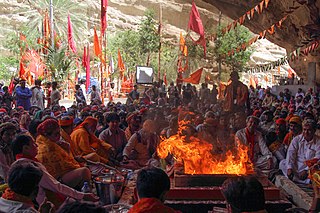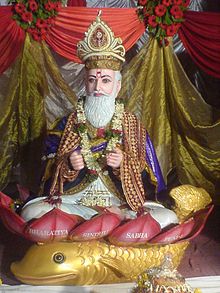
Hyderabad is a city and the capital of Hyderabad Division in the Sindh province of Pakistan. It is the second-largest city in Sindh, and the fifth largest in Pakistan.

Sindhis are an Indo-Aryan ethnolinguistic group who speak the Sindhi language and are native to the Sindh province of Pakistan. The historical homeland of Sindhis is bordered by the southeastern part of Balochistan, the Bahawalpur region of Punjab and the Kutch region of Gujarat. Having been isolated throughout history, unlike its neighbours, Sindhi culture has preserved its own uniqueness.

Ulhasnagar is a city located, just 26 km from Thane City in Thane district, Maharashtra, India. This city is a part of Mumbai Metropolitan Region managed by MMRDA. It had an estimated population of 506,098 at the 2011 Census. Ulhasnagar is a municipal city and the headquarters of the Tahsil bearing the same name. It has a suburban station on the Central line of the Mumbai Suburban Railway.

Hinduism is the second largest religious affiliation in Pakistan after Islam. Though Hinduism was one of the dominant faiths in the region a few centuries ago, Hindus accounted for just 2.14% of Pakistan's population in the 2017 Pakistani census. The Umerkot district has the highest percentage of Hindu residents in the country at 52.2%, while Tharparkar district has the most Hindus in absolute numbers at 714,698.
Lohana are a trading or mercantile jāti mostly in India and also in Pakistan.

The Hyderabad (Sind) National Collegiate Board or HSNC Board is an Indian non-profit organisation founded in 1922 in the British India province of Sind and moved to Bombay, India after the 1947 Partition. It is one of the oldest educational trusts of India and currently administers 27 institutes under its umbrella including the HSNC University, Mumbai.

Nanakpanthi, also known as Nanakshahi, is a Sikh sect which follows Guru Nanak (1469-1539), the founder of Sikhism.
The Kutchi people traditionally hail from the Kutch district of the western Indian state of Gujarat and the Sindh region of Pakistan.
Hirabad is one of the oldest parts of the city of Hyderabad in Sindh, Pakistan. Before partition in 1947, Hirabad was a thriving township of wealthy Hindu Sindwork merchants and traders who generally belonged to the Amil and Bhaiband castes of Hindu Lohanas.
Bhaiband, meaning “brotherhood”, are a Hindu jāti within the Sindhi caste of India and Pakistan.

Sindhi cinema refers to the Sindhi language film industry in Sindh, Pakistan and among the Sindhi diaspora specially in India.

The Sindhi diaspora consists of Sindhi people who have emigrated from the historical Sindh province of British India, as well as the modern Sindh province of Pakistan, to other countries and regions of the world, as well as their descendants.
Sindhis in India refer to a socio-ethnic group of people living in the Republic of India, originating from Sindh. After the 1947 Partition of India into the dominions of new Muslim-majority Pakistan and remaining Hindu-majority India, a million non-Muslim Sindhis migrated to independent India. As per the 2011 census of India, there are 2,772,364 Sindhi speakers in the Indian Republic. However, this number does not include ethnic Sindhis who no longer speak the language.
The Amils are a Sindhi sub-group of Bhaiband Lohana. The word "Amil" has its origin in the Persian word "amal". Amils used to work in Administration in Government services.
Sahiti or Sahta sometimes Sahitiaja are sub group/caste of Lohana community, Sahitis and, together with the Amils and Bhaiband, form one of the three major groups of Lohana caste in Sindh, Pakistan.
British Sindhis are British citizens or residents who are of Sindhi origin. They comprise a sizable segment of the British Pakistani and British Indian communities.
Popati Hiranandani was an Indian writer who authored more than sixty books in Sindhi language during her life. She was an essayist, fiction writer, poet, educationist, feminist and social activist. She made significant contributions to Sindhi literature before and after the partition of India. She won several awards including the Sahitya Akademi Award (1982), Woman of the Year Award (1988), and the Gaurav Puraskar (1990) among others.
Bhagnari is a Sindhi Hindu and Sikh community living in India and Pakistan. They lived in Bhag Nari area of Kachhi district in Balochistan. They migrated to India after Partition.

Hinduism is the second-largest religion in Sindh, numbering 4.17 million people and comprising 8.73 percent of the province's population in the 2017 Pakistani census. Sindh has the largest population and the highest percentage of Hindus in Pakistan. Sindh has the Shri Ramapir Temple, whose annual festival is the country's second-largest Hindu festival.








